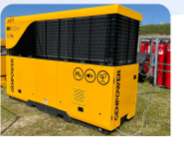
Harnessing Hydrogen Power: The Rise of Water Electrolysis Generators
Hydrogen, the most abundant element in the universe, has long been hailed as a potential key to a cleaner, more sustainable energy future. With the push for decarbonization and renewable energy gaining momentum, the technology that enables the direct production of hydrogen gas is increasingly under the spotlight. Enter water electrolysis generators, the unsung heroes of the hydrogen revolution.
Understanding the Magic of Electrolysis
At its core, an electrolysis generator is a rather simple device with profound potential. Electrolysis is the chemical decomposition of a solution or a compound into its constituent elements by passing an electric current through it. In the context of water, this means the breakdown of H2O into hydrogen (H2) and oxygen (O2). This process, if powered by renewable energy sources such as solar or wind, offers a tantalizing vision of a carbon-neutral energy cycle, with water acting as the fuel and the only byproduct being pure, breathable oxygen.
The Nuts and Bolts
Water electrolyzers are typically composed of three main components:
• Anode and Cathode: These electrodes facilitate the electrochemical reactions, with the anode generating oxygen and the cathode producing hydrogen.
• Proton Exchange Membrane (PEM) or Alkaline Electrolyte: This separates the gas produced at the cathode and anode and helps in the transfer of protons across the cell.
• Power Supply: An external source such as solar, wind, or grid electricity provides the necessary voltage to split the water molecules.
The efficiency of these systems, often measured in terms of their energy conversion efficiency, is a key area of research and development. High efficiency electrolyzers can convert a greater percentage of the input energy into the chemical energy of hydrogen, making the overall hydrogen production process more sustainable.
Electrolyzers and the Energy Ecosystem
The potential applications for electrolysis are as wide as they are varied. They range from large-scale industrial plants, which are the current focus of the hydrogen economy, to small-scale and portable systems, which could find uses in remote and off-grid locations. The versatility of electrolysis technology means that it can be adapted to a diverse set of contexts, each with its unique energy demands and sources.
Green Hydrogen for Industry
Industries such as steel and fertilizer production, where hydrogen is a key input, are beginning to turn to green hydrogen—produced via water electrolysis—to reduce their carbon footprint. These industrial electrolyzers are often large-scale and high-capacity, with the potential to generate significant amounts of hydrogen.
Fueling the Future
One of the most exciting prospects is the use of electrolyzers to power fuel cells in vehicles. By coupling an electrolyzer with a hydrogen fuel cell, it’s possible to create a closed-loop, emission-free system. The promise of fuel cell vehicles is already being realized by companies investing in hydrogen-powered fleets, and the wider adoption of this technology could revolutionize the transportation sector.
Decentralized Energy Solutions
The portability and modularity of certain electrolysis systems open doors to decentralized energy solutions, particularly in areas with unreliable or non-existent power grids. Small-scale hydrogen generators can act as energy storage solutions that, when coupled with renewable sources, offer a consistent and sustainable energy supply.
The Road Ahead for Electrolysis
Despite the potential, there are still challenges that need to be addressed for electrolysis to play a significant role in the energy transition. The cost of electrolyzers, both in terms of initial investment and ongoing maintenance, remains a significant barrier to widespread adoption. Further innovation and economies of scale are needed to drive these costs down.
Additionally, the current state of hydrogen infrastructure, including storage and distribution, is not yet mature. Building out this infrastructure to support the increased production and utilization of hydrogen generated by electrolysis will be a crucial step in realizing the full potential of this technology.
Technological Innovations
The future of water electrolysis lies in technological advancements that increase efficiency, lower costs, and enhance the durability of hydrogen generator (Waterstof generator) systems. Materials science, particularly the development of catalysts that can improve the kinetics of the electrochemical reactions, continues to be an area of intensive study.
Policy and Investment
Policy frameworks and investment initiatives will also play a critical role in accelerating the adoption of electrolysis technology. Subsidies, tax incentives, and funding for research will be essential in driving down costs and making electrolysis more competitive with traditional means of hydrogen production.
The journey toward a hydrogen-based economy is just beginning, and water electrolysis generators are poised on the frontlines, ready to transform the way we think about and use energy. With the right combination of technology, policy, and investment, these unassuming devices have the power to revolutionize our energy landscape.